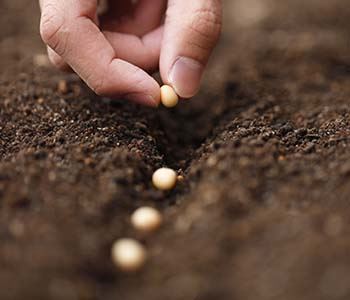Cover Crops Help Stabilize the Future of Farm Land
Jun 26, 2018

Cover crops continue to gain popularity as a way to improve farm ground. The regenerative agriculture movement is quickly showing an impact on the way they can improve soil structure and keep nutrients in place.
“The land is our most valuable resource so we should do everything we can to make it better,” said Chris Thompson, MKC Strategic Account Manager.
That’s where cover crops come in.
A cover crop is planted right after a commercial crop harvest to aid in protecting and enriching the soil. The benefits of using cover crops are: they forage for nutrients, cover the soil, increase the natural flow of carbon from the air to the soil and can reduce herbicide usage.
Using a multi-specie mix is a determining factor in cover crop outcomes. Blends that use several different plants can benefit the soil in multiple ways. For instance, a combination of radish and cowpeas can simultaneously reduce compaction and add nitrogen to the soil. The more diversity in a blend, the more likely plants will work together to better the soil life.
MKC is offering two different cover crop mixes. The first is a drought-resistant summer mix, which is a cover crop planted after harvesting a winter wheat crop. Made of sorghum-sudangrass, millet and tillage radish, the summer mix can build biomass above ground. This mix features deep-penetrating roots that increase moisture and nutrient seeking abilities and helps reduce soil compaction. The MKC fall mix consists of oats, cereal rye, radish, and turnips. A fall mix is planted after corn and soybean harvest. The fall mix is primarily for weed suppression but can reduce herbicide run-off and wind erosion.
The challenges that growers continually face with cover crops are weed pressure, herbicide carryover restrictions, and in some cases insects depending on which cover crop a grower is trying.
“When planning a cover crop, we narrow down what the resource concern is, figure out the problems we are trying to address and then plan the best way to make the operation work within our geographical area and environment,” said Thompson. MKC will work with each grower to figure out what cover crop mixes work best for each grower because no two farms are alike.
When a grower debates planting cover crops, they must consider cost, benefits, long-term impact and the amount of labor involved. With help from strategic account managers at MKC, growers can accurately make the right decision for their land.
Some growers have planted cereal rye behind corn as a living cover through the winter and to grow biomass during the spring, which saves a grower herbicide costs in the spring, Thompson also added there are a lot of success stories when growers use cover crops for grazing serving dual-purpose, providing a free grazing resource as well.
Another advancement that MKC has achieved would be reducing the amount of herbicide passes made on a field. One grower was able to go from three herbicide applications to one in an entire year. “Last summer was pretty dry, and the grower had all this residue left over. It looked like he just laid the whole field down. He had moisture the whole summer, and he probably saved at least $40 an acre in herbicide,” said Thompson.
“Several farmers and ranchers are trying them and seeing how they fit on their operation,” Thompson said. “But still, the percent off acres with cover crops can be very low.” If implemented effectively, Thompson says cover crops are a fantastic option for holding soil in place, enriching the soil and capturing nutrients left behind.
Thompson is passionate about sharing his cover crop knowledge and resources with growers and the MKC team. “We have one shot a year at using a certain mix. MKC knows the customer’s operation to delve into what they want and need. Our job is to make them successful,” he said. Farmers interested in learning more about cover crops should visit with their nearest MKC location or strategic account manager.
Written by: Kylee Martin, MKC communications intern